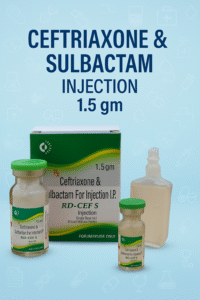How Ceftriaxone & Sulbactam Injection 1.5 gm Works – Medical Insights
When it comes to treating severe bacterial infections, time is critical—and so is choosing the right antibiotic. One powerful and commonly used combination in hospitals is Ceftriaxone Sulbactam Injection 1.5 gm. If you or a loved one has been prescribed this injection, understanding how it works can ease some of the anxiety and help you feel more informed about your treatment.
In this blog, we’ll break down the action, uses, dosage, and precautions of Ceftriaxone & Sulbactam Injection 1.5 gm in simple, relatable terms.




What Is Ceftriaxone & Sulbactam Injection 1.5 gm?
This injectable antibiotic is a fixed-dose combination of two active ingredients:
- Ceftriaxone (1 gm) – a third-generation broad-spectrum cephalosporin antibiotic.
- Sulbactam (0.5 gm) – a beta-lactamase inhibitor that enhances the action of ceftriaxone.
Together, these two components form a powerful duo against various types of bacterial infections, especially those that are difficult to treat with standard antibiotics.
How Does It Work?
Let’s break this down in everyday language.
🦠 Ceftriaxone – The Fighter
Ceftriaxone works by inhibiting bacterial cell wall synthesis. Without their protective walls, bacteria can’t survive. It targets a wide range of Gram-positive and Gram-negative bacteria, making it effective in treating many types of infections.
🛡️ Sulbactam – The Bodyguard
Many bacteria have developed resistance over time by producing an enzyme called beta-lactamase, which destroys antibiotics like ceftriaxone. Sulbactam blocks this enzyme, essentially protecting ceftriaxone from being broken down and allowing it to work better and for longer.
Together, they offer a broad-spectrum, synergistic approach, especially useful in serious hospital-acquired infections or resistant community infections.
When Is This Injection Prescribed?
Ceftriaxone & Sulbactam 1.5 gm Injection is typically used in moderate to severe infections. Doctors prescribe it for:
- Respiratory tract infections (pneumonia, bronchitis)
- Urinary tract infections (complicated UTIs)
- Skin and soft tissue infections
- Intra-abdominal infections
- Bone and joint infections
- Septicemia (blood infections)
- Post-surgical infections
- Pelvic inflammatory disease and gynecological infections
Because of its powerful nature, this injection is mostly used in hospitals or clinical settings under strict medical supervision.
Dosage and Administration
💉 Standard Dosage
The usual adult dose is 1.5 gm (Ceftriaxone 1 gm + Sulbactam 0.5 gm) given once or twice daily via intravenous (IV) infusion or intramuscular (IM) injection, depending on the severity of the infection.
📅 Course Duration
The course typically lasts between 5 to 14 days, but your doctor will decide based on your condition, response, and lab results.
🏥 Important Notes:
- It must be administered by a healthcare professional.
- Never self-inject or stop the treatment mid-way unless advised.
- Dosage may be adjusted for patients with kidney or liver problems.




Benefits of Ceftriaxone-Sulbactam Combination
- Broad-spectrum action – Covers more bacteria than ceftriaxone alone.
- Effective against resistant strains – Thanks to Sulbactam.
- Convenient dosing – Usually once or twice daily.
- Hospital-grade potency – Trusted in serious infections.
- Reduced need for multiple antibiotics – A single combo covers multiple pathogens.
Possible Side Effects and Precautions
Like all medications, Ceftriaxone Sulbactam Injection may have side effects, although not everyone experiences them.
🟡 Common Side Effects:
- Pain or swelling at the injection site
- Mild diarrhea or gastrointestinal discomfort
- Headache or dizziness
- Skin rash or itching
🔴 Serious (but rare) Side Effects:
- Severe allergic reactions (anaphylaxis)
- Difficulty breathing
- Liver or kidney dysfunction
- Blood disorders




👉 Inform your doctor immediately if you experience any unusual symptoms during the treatment.
⚠️ Precautions:
- Let your doctor know if you have kidney or liver disease.
- Avoid if allergic to penicillin or cephalosporins.
- Use in pregnancy or breastfeeding only if clearly needed.
- Stay hydrated and eat light, especially if on antibiotics for long durations.
Storage and Handling
Hospitals and clinics usually manage this, but if prescribed at home:
- Store the injection in a cool, dry place (usually below 25°C).
- Do not freeze.
- Protect from direct sunlight and moisture.
- Once reconstituted, the solution should be used immediately or within the advised time.
Cost and Availability
The price of Ceftriaxone Sulbactam 1.5 gm Injection can vary depending on the brand, manufacturer, and location, but it remains a cost-effective option for treating serious infections when compared to newer-generation antibiotics.
It’s manufactured by several Indian and global pharmaceutical companies, ensuring wide availability in hospitals and pharmacies across regions.
Final Thoughts: A Lifesaving Combo When Used Right
Ceftriaxone & Sulbactam Injection 1.5 gm is more than just a medication—it’s a critical tool in fighting severe infections that don’t respond to first-line treatments. It works by pairing a strong antibiotic with a beta-lactamase inhibitor, overcoming bacterial resistance and speeding up recovery.
That said, it’s not something to take lightly. Always follow medical guidance, complete the full course, and communicate openly with your healthcare provider if you notice any side effects.

